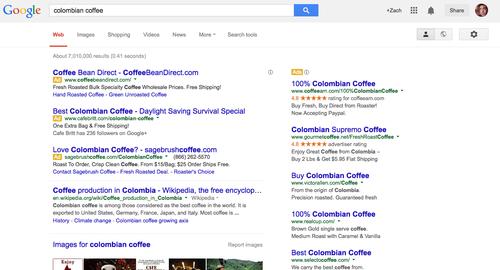
Google's search results page, as pictured in March 2014, uses a new "Ad" icon to denote advertiser links.
Google is testing some changes to the way it displays search results, including a tweak to how it presents paid links that could throw off unsuspecting users.
Paid links in Google's search results are marked today with a yellow shaded background. Under the experimental layout, which is being widely tested with users, a small yellow button that says "Ad" appears in front of paid links instead.
For some users, the new labeling may suffice to denote what's an ad and what's not. But those not paying close attention might find themselves directed to a promotional site without asking for it.
"For users who avoided ads before, it will be harder for them to tell the difference," said Mike Mothner, CEO of Wpromote, an online marketing agency that manages companies' SEO campaigns.
The effect, he said, is that paid links blend in more with the organic search results, and more people will click on them.
If the ads are well-targeted and users want to see them, it could still be a win-win for users and advertisers, said Mothner, whose company's clients include Toyota, Ford and the Universal Music Group.
Google started testing the new design late last year on mobile devices, as part of a refresh of its results page that also includes a larger font size and removing the underlines in links.
"We're continuing to roll this out on the desktop as well, to provide a consistent experience with our products across screens," a Google spokesman said. The company didn't say if and when the new layout will be rolled out to all users.
Some don't think the goal is to get users to click on more paid links.
"Does Google want to increase its click-through rates as much as possible? Yes," said Leo Dalakos, VP of performance media at Performics, a digital marketing agency. But it's not in the company's best interests to have users accidentally click on ads, he said. Doing so might reduce their satisfaction with the service and tempt them to look elsewhere.
The experiment is the latest in a series of tests that play a critical role in how Google designs its products. The company has tested 70 shades of blue just for the color of its links, Dalakos said.
Other Google experiments have involved linking people's geographic location with the ads they're shown and the placement of images alongside ads.
Zach Miners covers social networking, search and general technology news for IDG News Service. Follow Zach on Twitter at @zachminers. Zach's e-mail address is zach_miners@idg.com
Join the CIO Australia group on LinkedIn. The group is open to CIOs, IT Directors, COOs, CTOs and senior IT managers.
